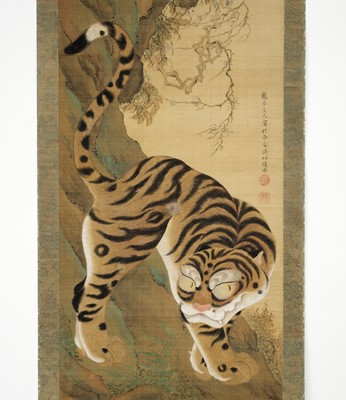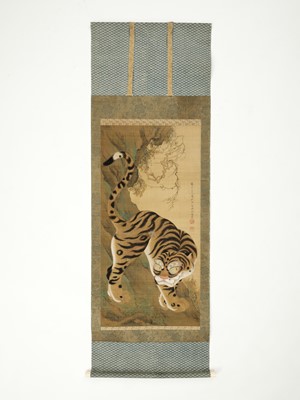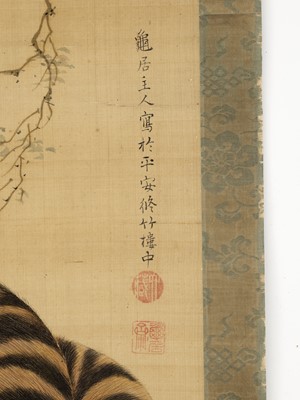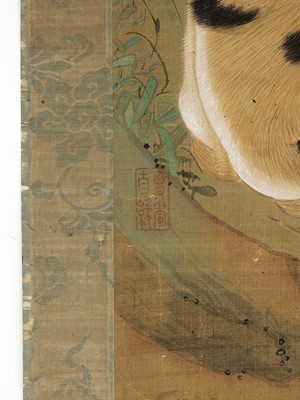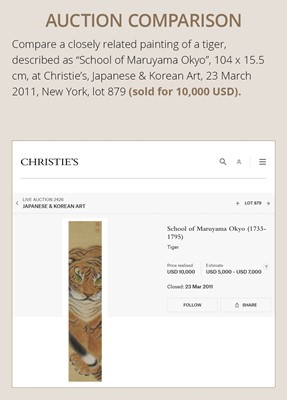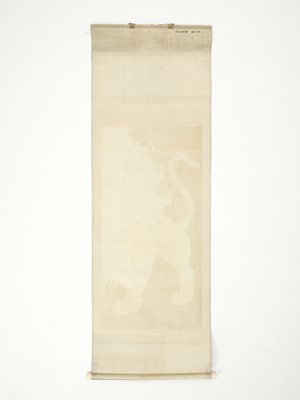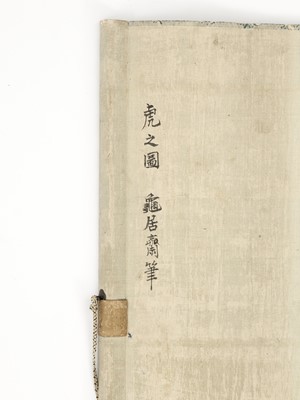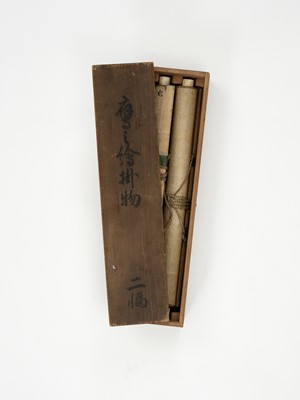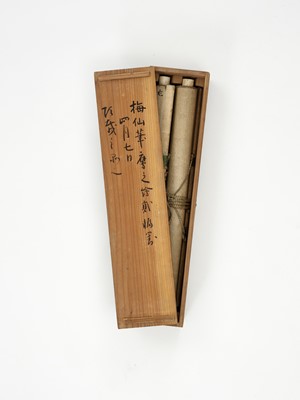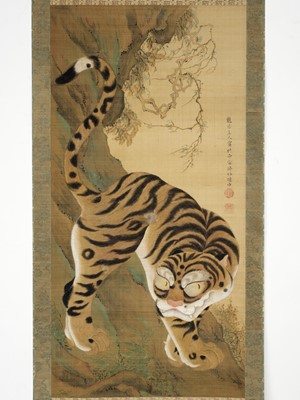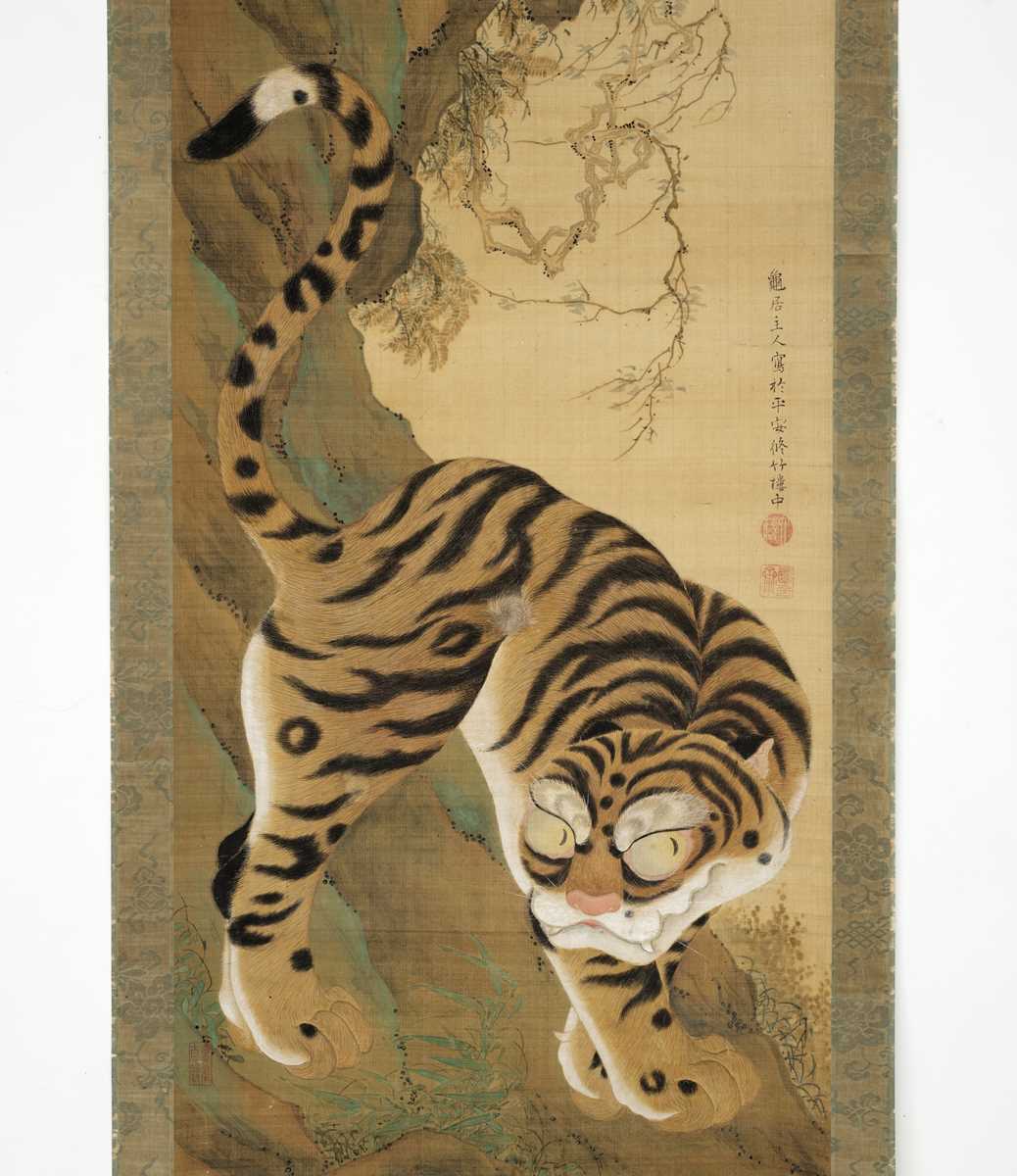2nd Dec, 2022 13:00
Fine Japanese Art
100
A FINE SCROLL PAINTING OF A TIGER, SCHOOL OF MARUYAMA OKYO
Sold for €3,120
including Buyer's Premium
Inscribed Kamei and sealed Anagura and Kameisai
Japan, Kyoto, late 18th – early 19th century, Edo period (1615-1868)
Finely painted in ink and watercolors on silk, with a silk brocade frame and mounted as a hanging scroll, depicting a tiger standing foursquare on a rocky slope, with brown leaves and twisted vines and roots in the background, as well as bamboo leaves below the tiger, calling to mind the popular motif take no tora (tiger in bamboo). The tiger’s striped fur is neatly detailed and both its large side-glancing eyes and dynamic pose suggest a certain mischief to the mysterious animal. Inscribed and signed center right, ‘KAMEI shujin, Heian shuchikuro chu ni oite utsutsu’ (‘Painted by Master Kamei, at the Shuchikuro Studio, Kyoto’).
SIZE 103 x 51 cm (image) and 178 x 67 cm (total)
Condition: Very good condition with minor wear, creasing, little soiling, the brocade frame with few minuscule losses to edges.
Provenance: From a private collection, Illinois.
Although there is no information available about this artist, it is likely that he was a follower of Maruyama Okyo (1733-1795). The name Kamei literally means ‘Turtle Abode’. Maruyama Okyo and his students painted numerous paintings for the Daijoji Temple, whose mountain name (sango) is Kamei Temple (also known as Okyo Temple); the commission was carried out at the Okyo's studio in Kyoto, though the Kamei Temple (Okyo Temple) is located in nearby Hyogo.
Tiger imagery has a long history in East Asia. Tigers were frequently paired with dragons—the tiger representing the ‘male’ principle, the yin to the female ‘yang’ of the dragon, ancient cosmological symbols. Tigers are also commonly paired with bamboo, which is known as take no tora, or ‘tiger in bamboo’, and has many different interpretations; the tiger has a strong nature, is flexible and resilient like the bamboo, but it is also said that the strong tiger is looking for shelter underneath the bamboo, as any earthly power is inferior to the forces of nature. Moreover, the tiger and bamboo represent the power of faith in Buddhism.
Auction comparison:
Compare a closely related painting of a tiger, described as “School of Maruyama Okyo”, 104 x 15.5 cm, at Christie’s, Japanese & Korean Art, 23 March 2011, New York, lot 879 (sold for 10,000 USD).
Inscribed Kamei and sealed Anagura and Kameisai
Japan, Kyoto, late 18th – early 19th century, Edo period (1615-1868)
Finely painted in ink and watercolors on silk, with a silk brocade frame and mounted as a hanging scroll, depicting a tiger standing foursquare on a rocky slope, with brown leaves and twisted vines and roots in the background, as well as bamboo leaves below the tiger, calling to mind the popular motif take no tora (tiger in bamboo). The tiger’s striped fur is neatly detailed and both its large side-glancing eyes and dynamic pose suggest a certain mischief to the mysterious animal. Inscribed and signed center right, ‘KAMEI shujin, Heian shuchikuro chu ni oite utsutsu’ (‘Painted by Master Kamei, at the Shuchikuro Studio, Kyoto’).
SIZE 103 x 51 cm (image) and 178 x 67 cm (total)
Condition: Very good condition with minor wear, creasing, little soiling, the brocade frame with few minuscule losses to edges.
Provenance: From a private collection, Illinois.
Although there is no information available about this artist, it is likely that he was a follower of Maruyama Okyo (1733-1795). The name Kamei literally means ‘Turtle Abode’. Maruyama Okyo and his students painted numerous paintings for the Daijoji Temple, whose mountain name (sango) is Kamei Temple (also known as Okyo Temple); the commission was carried out at the Okyo's studio in Kyoto, though the Kamei Temple (Okyo Temple) is located in nearby Hyogo.
Tiger imagery has a long history in East Asia. Tigers were frequently paired with dragons—the tiger representing the ‘male’ principle, the yin to the female ‘yang’ of the dragon, ancient cosmological symbols. Tigers are also commonly paired with bamboo, which is known as take no tora, or ‘tiger in bamboo’, and has many different interpretations; the tiger has a strong nature, is flexible and resilient like the bamboo, but it is also said that the strong tiger is looking for shelter underneath the bamboo, as any earthly power is inferior to the forces of nature. Moreover, the tiger and bamboo represent the power of faith in Buddhism.
Auction comparison:
Compare a closely related painting of a tiger, described as “School of Maruyama Okyo”, 104 x 15.5 cm, at Christie’s, Japanese & Korean Art, 23 March 2011, New York, lot 879 (sold for 10,000 USD).
Zacke Live Online Bidding
Our online bidding platform makes it easier than ever to bid in our auctions! When you bid through our website, you can take advantage of our premium buyer's terms without incurring any additional online bidding surcharges.
To bid live online, you'll need to create an online account. Once your account is created and your identity is verified, you can register to bid in an auction up to 12 hours before the auction begins.
Intended Spend and Bid Limits
When you register to bid in an online auction, you will need to share your intended maximum spending budget for the auction. We will then review your intended spend and set a bid limit for you. Once you have pre-registered for a live online auction, you can see your intended spend and bid limit by going to 'Account Settings' and clicking on 'Live Bidding Registrations'.
Your bid limit will be the maximum amount you can bid during the auction. Your bid limit is for the hammer price and is not affected by the buyer’s premium and VAT. For example, if you have a bid limit of €1,000 and place two winning bids for €300 and €200, then you will only be able to bid €500 for the rest of the auction. If you try to place a bid that is higher than €500, you will not be able to do so.
Online Absentee and Telephone Bids
You can now leave absentee and telephone bids on our website!
Absentee Bidding
Once you've created an account and your identity is verified, you can leave your absentee bid directly on the lot page. We will contact you when your bids have been confirmed.
Telephone Bidding
Once you've created an account and your identity is verified, you can leave telephone bids online. We will contact you when your bids have been confirmed.
Classic Absentee and Telephone Bidding Form
You can still submit absentee and telephone bids by email or fax if you prefer. Simply fill out the Absentee Bidding/Telephone bidding form and return it to us by email at office@zacke.at or by fax at +43 (1) 532 04 52 20. You can download the PDF from our Upcoming Auctions page.
How-To Guides
How to Create Your Personal Zacke Account
How to Register to Bid on Zacke Live
How to Leave Absentee Bids Online
How to Leave Telephone Bids Online
中文版本的操作指南
创建新账号
注册Zacke Live在线直播竞拍(免平台费)
缺席投标和电话投标
Third-Party Bidding
We partner with best-in-class third-party partners to make it easy for you to bid online in the channel of your choice. Please note that if you bid with one of our third-party online partners, then there will be a live bidding surcharge on top of your final purchase price. You can find all of our fees here. Here's a full list of our third-party partners:
- 51 Bid Live
- EpaiLive
- ArtFoxLive
- Invaluable
- LiveAuctioneers
- the-saleroom
- lot-tissimo
- Drouot
Please note that we place different auctions on different platforms. For example, in general, we only place Chinese art auctions on 51 Bid Live.
Bidding in Person
You must register to bid in person and will be assigned a paddle at the auction. Please contact us at office@zacke.at or +43 (1) 532 04 52 for the latest local health and safety guidelines.
